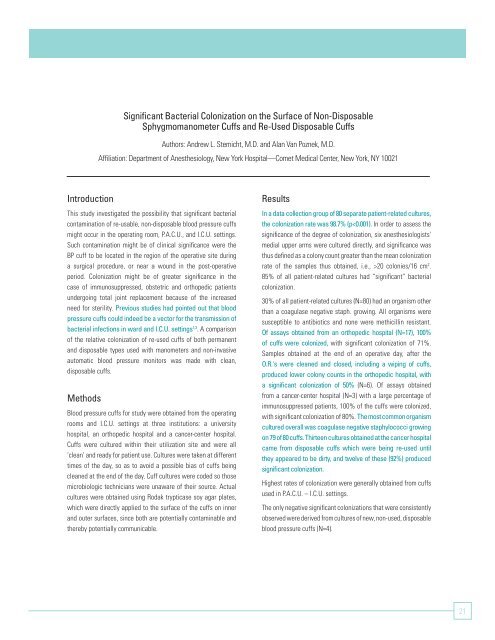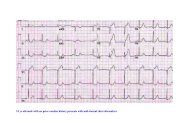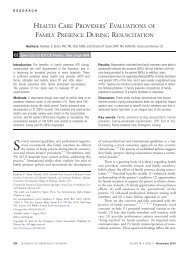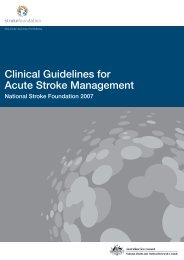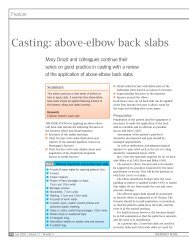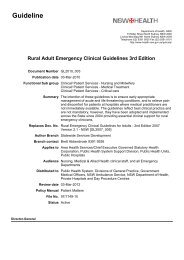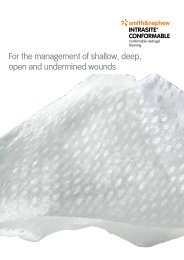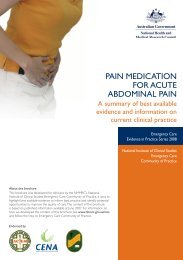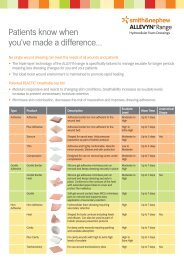Non Invasive Blood Pressure - Living on the EDge
Non Invasive Blood Pressure - Living on the EDge
Non Invasive Blood Pressure - Living on the EDge
Create successful ePaper yourself
Turn your PDF publications into a flip-book with our unique Google optimized e-Paper software.
Significant Bacterial Col<strong>on</strong>izati<strong>on</strong> <strong>on</strong> <strong>the</strong> Surface of <str<strong>on</strong>g>N<strong>on</strong></str<strong>on</strong>g>-Disposable<br />
Sphygmomanometer Cuffs and Re-Used Disposable Cuffs<br />
Authors: Andrew L. Stemicht, M.D. and Alan Van Poznek, M.D.<br />
Affiliati<strong>on</strong>: Department of Anes<strong>the</strong>siology, New York Hospital —Comet Medical Center, New York, NY 10021<br />
Introducti<strong>on</strong><br />
This study investigated <strong>the</strong> possibility that significant bacterial<br />
c<strong>on</strong>taminati<strong>on</strong> of re-usable, n<strong>on</strong>-disposable blood pressure cuffs<br />
might occur in <strong>the</strong> operating room, P.A.C.U., and I.C.U. settings.<br />
Such c<strong>on</strong>taminati<strong>on</strong> might be of clinical significance were <strong>the</strong><br />
BP cuff to be located in <strong>the</strong> regi<strong>on</strong> of <strong>the</strong> operative site during<br />
a surgical procedure, or near a wound in <strong>the</strong> post-operative<br />
period. Col<strong>on</strong>izati<strong>on</strong> might be of greater significance in <strong>the</strong><br />
case of immunosuppressed, obstetric and orthopedic patients<br />
undergoing total joint replacement because of <strong>the</strong> increased<br />
need for sterility. Previous studies had pointed out that blood<br />
pressure cuffs could indeed be a vector for <strong>the</strong> transmissi<strong>on</strong> of<br />
bacterial infecti<strong>on</strong>s in ward and I.C.U. settings 1,3 . A comparis<strong>on</strong><br />
of <strong>the</strong> relative col<strong>on</strong>izati<strong>on</strong> of re-used cuffs of both permanent<br />
and disposable types used with manometers and n<strong>on</strong>-invasive<br />
automatic blood pressure m<strong>on</strong>itors was made with clean,<br />
disposable cuffs.<br />
Methods<br />
<str<strong>on</strong>g>Blood</str<strong>on</strong>g> pressure cuffs for study were obtained from <strong>the</strong> operating<br />
rooms and I.C.U. settings at three instituti<strong>on</strong>s: a university<br />
hospital, an orthopedic hospital and a cancer-center hospital.<br />
Cuffs were cultured within <strong>the</strong>ir utilizati<strong>on</strong> site and were all<br />
‘clean’ and ready for patient use. Cultures were taken at different<br />
times of <strong>the</strong> day, so as to avoid a possible bias of cuffs being<br />
cleaned at <strong>the</strong> end of <strong>the</strong> day. Cuff cultures were coded so those<br />
microbiologic technicians were unaware of <strong>the</strong>ir source. Actual<br />
cultures were obtained using Rodak trypticase soy agar plates,<br />
which were directly applied to <strong>the</strong> surface of <strong>the</strong> cuffs <strong>on</strong> inner<br />
and outer surfaces, since both are potentially c<strong>on</strong>taminable and<br />
<strong>the</strong>reby potentially communicable.<br />
Results<br />
In a data collecti<strong>on</strong> group of 80 separate patient-related cultures,<br />
<strong>the</strong> col<strong>on</strong>izati<strong>on</strong> rate was 98.7% (p


